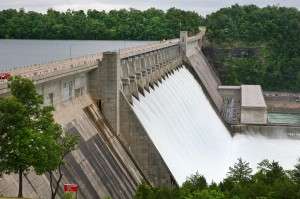
Bass anglers at Bull Shoals Lake often utter unkind words about the U.S. Army Corps of Engineers' operating plan for this big impoundment on the White River. This year is no exception, as the Corps has dropped the lake level almost 8 feet in the last three weeks – during prime time of the bass spawning season.
When the Bassmaster Elite Series TroKar Quest begins Thursday, Bull Shoals will be right at its "normal" or power pool level of 654 feet above sea level.
But the Corps has probably heard fewer discouraging words this year, after the flood that hit this area last spring. That operating plan and its main goal of flood control became clear for local residents after seeing the lake rise 32 feet in 10 days last April. And the lake level stayed historically high for another month, finally cresting at 696.49 feet.
It marked the second time in three years that the Corps has had to open the 17 floodgates on Bull Shoals Dam. The flood of 2008 wasn't as severe as last year's, but the high water did result in a "super spawn" of largemouth bass that Elite Series anglers will benefit from during this week's tournament.
"The largemouth bass spawn in 2008 produced an excellent class of fish that are now 14 to 17 inches long," said Ken Shirley, an Arkansas Game & Fish Commission biologist who has worked in this area since 1992. "The bass fishing should be about as good as it has been in a generation."
Although the bass spawned in the high water last spring are too young to be a factor in the tournament this week, the combination of it with the 2008 class should ensure that Bull Shoals bass fishing remains on the upswing for several years.
Bull Shoals has good populations of all three black bass species – largemouth, spotted and smallmouth. During spring seasons like this one, when the Corps is able to keep the lake at the power pool level, the smallmouth spawn is more successful.
"It will hurt the largemouth spawn this year," said Shirley of the recent draw-down. "But that's not a problem. We don't need to get a good largemouth spawn every year, because the smallmouth and spotted bass do better when the lake isn't high.
"And the smallmouth population is in very good shape. You'll see a lot of good smallmouth come in at the weigh-ins."
Bull Shoals has produced both the state record smallmouth bass (7 pounds, 5 ounces in 1969) and the state record spotted bass (7 pounds, 15 ounces in 1983). Bull Shoals Lake extends into Missouri, and it has also produced that state's largemouth bass record of 13 pounds, 14 ounces, caught in 1961.
Bull Shoals has minimum length limits of 15 inches for both largemouth and smallmouth and 12 inches for spotted bass.
Shirley and other AGFC fisheries biologists just completed their annual electro-fishing studies on both Bull Shoals and nearby Norfork lakes.
"Bass are in the mid to late stages of the spawn," Shirley said. "I'm guessing there will be a lot of males guarding the nests."
If any Elite Series anglers are looking for flooded vegetation to fish this week on Bull Shoals, they'll be out of luck. What they're going to see is a rocky 700-mile shoreline around this 45,000-acre lake. It will appear as if the lake is low. But it actually indicates how important this lake is in the flood control plan for the White River.
Bull Shoals is the biggest and last Corps-operated lake on the White River. The three-lake chain begins at Beaver Lake in northwest Arkansas, and extends into Missouri with Table Rock Lake, near Branson, before ending with Bull Shoals. Bull Shoals not only covers the most acreage of the three at its power pool level, it also has the largest flood pool, of 41 feet. When Bull Shoals is at the top of the flood pool at 695 feet above sea level, its shoreline expands to 1,000 miles and it covers 70,000 acres.
Last spring all three lakes were above maximum flood pool storage at some point. During a one-week period in late April, rainfall totals in all three drainages exceeded 10 inches. All that water put the Corps of Engineers flood control plan to the biggest test in its history.
You have to go a bit further back in history to see why these dams were built in the first place. The Great Mississippi River Flood of 1927 is considered the most destructive in U.S. history. Deaths were recorded in seven states due to the flood. Arkansas was among the hardest hit as 14 percent of it was under water, primarily in the Delta, where the Mississippi River grew to 60 miles wide just below Memphis.
After the White River leaves the Ozarks, it flows through Arkansas' flat Delta lands before meeting the Mississippi. The three large hydro-power dams on the White River were planned as part of the Flood Control Act of 1938. Bull Shoals Dam, when completed in 1951, was the fifth largest in the world.
Flood control, not a successful largemouth bass spawn, has always been the priority in the management of these lakes. And last spring was a reminder. The White River Basin lakes and levees have prevented more than $1 billion in flood losses, according to the Corps of Engineers.
